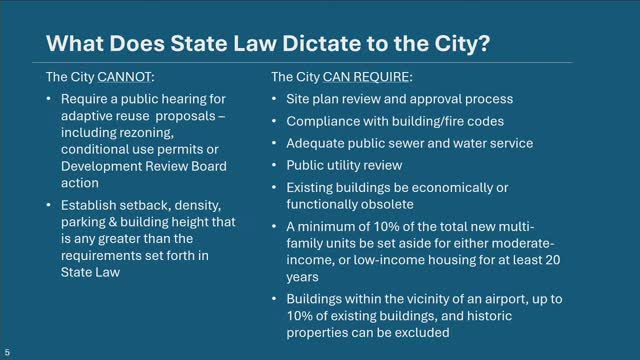New housing regulations spark debate over density limits
October 24, 2024 | Scottsdale, Maricopa County, Arizona
This article was created by AI summarizing key points discussed. AI makes mistakes, so for full details and context, please refer to the video of the full meeting. Please report any errors so we can fix them. Report an error »

In a recent government meeting, officials discussed critical regulations surrounding multifamily housing conversions, focusing on density and building height requirements. The conversation highlighted that these parameters are determined by existing multifamily structures within a one-mile radius of the proposed site. If no such structures exist, the regulations default to lower limits set by the zoning ordinance.
Commissioners emphasized that they cannot impose stricter limits than those established by nearby developments. For instance, if a nearby multifamily building is four stories tall, the proposed development cannot be restricted to three stories. Similarly, if the density of nearby developments allows for 40 units per acre, the proposed project must adhere to that density, as mandated by state statute.
The discussion also touched on the implications of transitioning from commercial to residential zoning, clarifying that the one-mile radius rule does not apply in such cases. While acknowledging the hard work of staff and legal teams in drafting these regulations, some commissioners expressed concerns regarding compliance with state law, specifically referencing HB 2297. This law stipulates that at least 10% of converted units must be designated for moderate or low-income housing, yet the proposed amendment only allows for 1% of eligible units to be converted for this purpose.
Commissioners voiced apprehension that this discrepancy could undermine the intent of the state law and negatively impact the community, urging a reevaluation of the proposed text amendment to better align with the spirit of the legislation.
Commissioners emphasized that they cannot impose stricter limits than those established by nearby developments. For instance, if a nearby multifamily building is four stories tall, the proposed development cannot be restricted to three stories. Similarly, if the density of nearby developments allows for 40 units per acre, the proposed project must adhere to that density, as mandated by state statute.
The discussion also touched on the implications of transitioning from commercial to residential zoning, clarifying that the one-mile radius rule does not apply in such cases. While acknowledging the hard work of staff and legal teams in drafting these regulations, some commissioners expressed concerns regarding compliance with state law, specifically referencing HB 2297. This law stipulates that at least 10% of converted units must be designated for moderate or low-income housing, yet the proposed amendment only allows for 1% of eligible units to be converted for this purpose.
Commissioners voiced apprehension that this discrepancy could undermine the intent of the state law and negatively impact the community, urging a reevaluation of the proposed text amendment to better align with the spirit of the legislation.
View full meeting
This article is based on a recent meeting—watch the full video and explore the complete transcript for deeper insights into the discussion.
View full meeting
